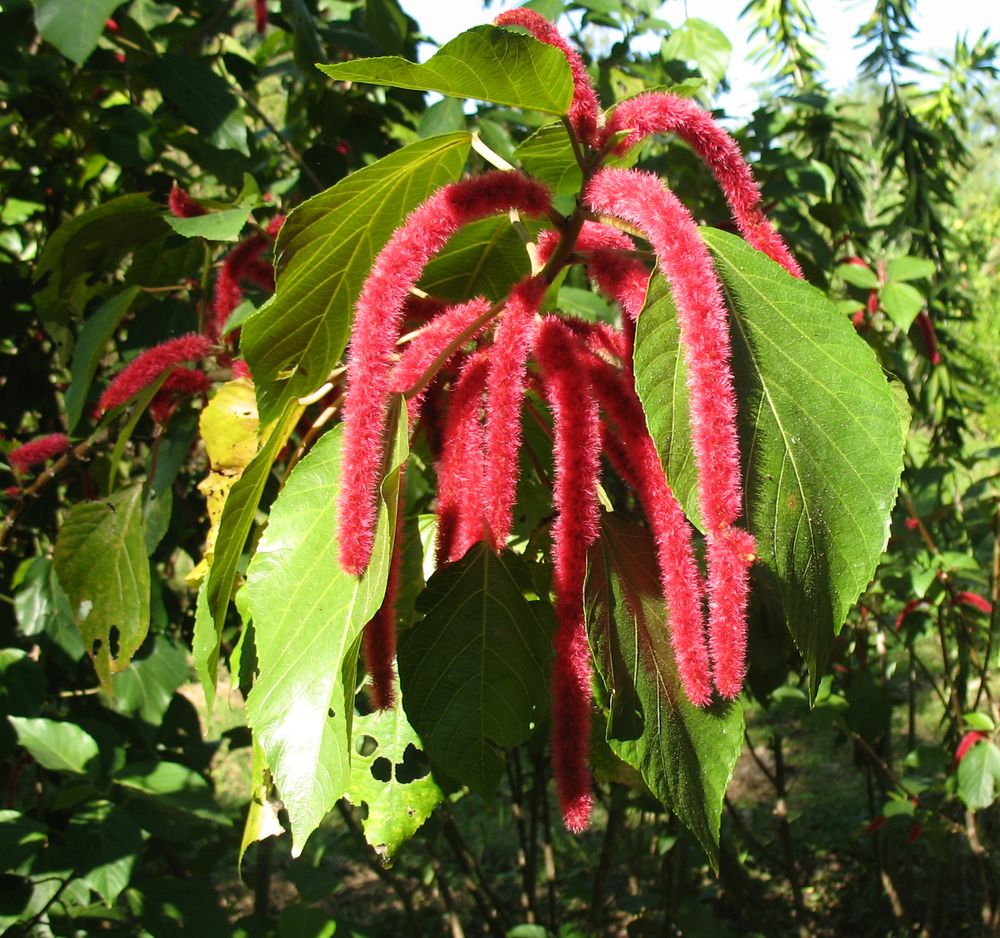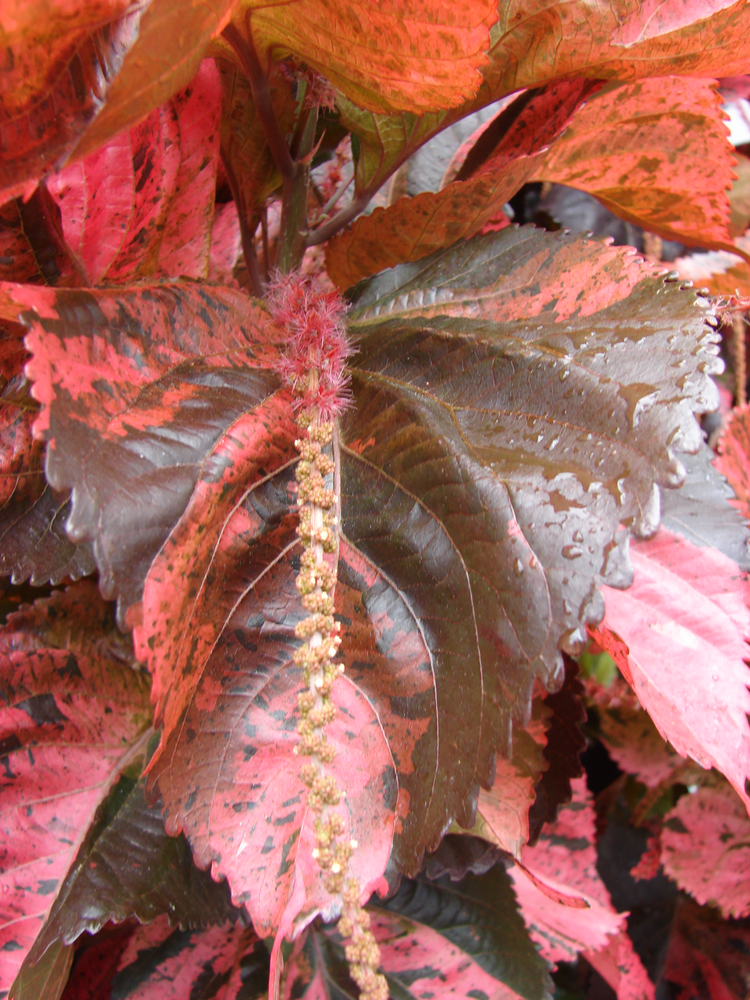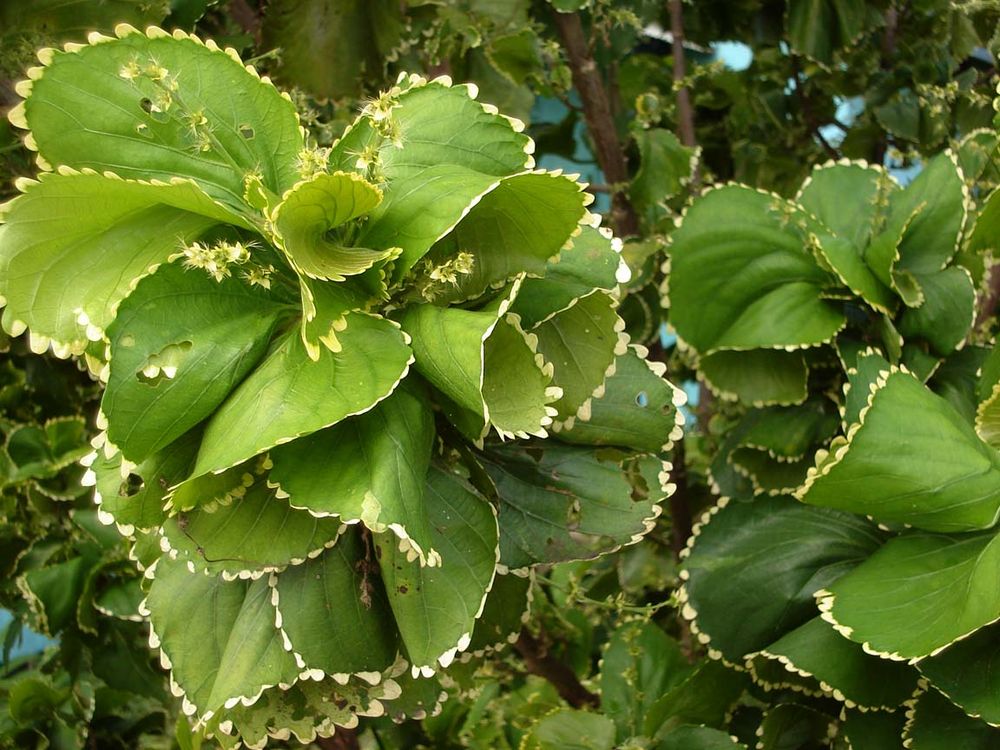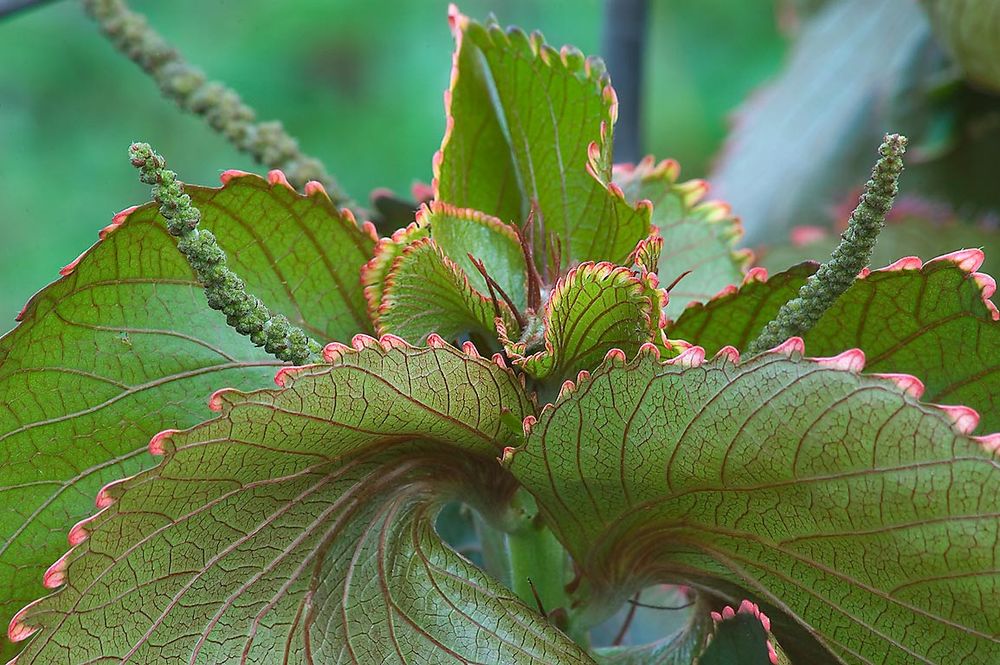We remain in ornamental plants with the « caterpillar plant » which belongs to the large Euphorbiaceae family characterized, among other things, by a sap containing a milky juice that is toxic and irritating to the skin. The genus Acalypha includes around 400 species, they are all in tropical or subtropical regions but botanists are hesitant about the origin of Acalypha hispida, probably between India and Oceania.
It is a beautiful shrub with a bushy habit, branching naturally. Its foliage is evergreen, dark green, slightly downy; the leaves are alternate, ovoid, with a toothed margin. The male and female flowers appear on different feet (the plant is dioecious), the males are very small and green, the females are also very small, without petals, like red catkins, but they constitute hanging inflorescences which can reach 60 cm long and which look great. The fruits are tiny capsules with three lobes. It is these inflorescences which determine most of the vernacular names, we see them as tails, of a cat, of a fox, of a squirrel (in Lao) or even like caterpillars; As for the scientific name, it comes from Greek and means “nettle” because the leaves are toothed like those of this plant.
We see hang karok quite often in Lao gardens and another related species, Acalypha wilkesiana, which we call here hou ling, “monkey ears”. The shrub has the same size but its flower spikes are smaller, on the other hand it is very decorative due to the wide variety of colors of its leaves which can be stained with red, pink, brown, bronze, orange, yellow and sometimes bordered with whit; this last variety bears the pretty name of “cancan petticoat” in Creole because the foliage resembles the dress of a French cancan dancer.
These plants would be used in our region as a laxative; in India they are given antimalarial, analgesic and healing properties and laboratory studies are carried out in this direction.
Nous restons dans les plantes d’ornement avec la plante chenille qui appartient à la grande famille des Euphorbiacées se caractérisant, entre autres, par une sève contenant un suc laiteux toxique et irritant pour la peau. Le genre Acalypha comprend environ 400 espèces, elles sont toutes dans les régions tropicales ou subtropicales mais les botanistes hésitent quand à l’origine d’Acalypha hispida, sans doute entre l’Inde et l’Océanie.
C’est un bel arbuste au port buissonnant, se ramifiant naturellement. Son feuillage est persistant, vert foncé, légèrement duveteux; les feuilles sont alternes, ovoïdes, avec une marge dentée. Les fleurs mâles et femelles apparaissent sur des pieds différents (la plante est dioïque), les mâles sont très petites et vertes, les femelles sont également très petites, sans pétales, comme des chatons rouges, mais elles constituent des inflorescences pendantes qui peuvent atteindre 60 cm de long et qui sont du plus bel effet. Les fruits sont des capsules minuscules à trois lobes. Ce sont ces inflorescences qui déterminent la plupart des noms vernaculaires, on les voit comme des queues, de chat, de renard, d’écureuil (en lao) ou encore comme des chenilles; quant au nom scientifique il vient du grec et signifie « ortie » car les feuilles sont dentées comme celles de cette plante.
On voit assez souvent hang karok dans les jardins lao et une autre espèce voisine, Acalypha wilkesiana, que l’on nomme ici hou ling, « oreilles de singe ». L’arbuste a la même taille mais ses épis floraux sont plus petits, en revanche il est très décoratif par la grande variété des couleurs de ses feuilles qui peuvent être tachées de rouge, rose, brun, bronze, orange, jaune et parfois ourlées de blanc; cette dernière variété porte en créole le joli nom de « jupon cancan » car le feuillage ressemble à la robe d’une danseuse de french cancan.
Ces plantes seraient dans notre région utilisées comme laxatif; en Inde on leur accorde des propriétés antipaludiques, analgésiques et cicatrisantes et des études de laboratoire sont menées dans ce sens.




We remain in ornamental plants with the « caterpillar plant » which belongs to the large Euphorbiaceae family characterized, among other things, by a sap containing a milky juice that is toxic and irritating to the skin. The genus Acalypha includes around 400 species, they are all in tropical or subtropical regions but botanists are hesitant about the origin of Acalypha hispida, probably between India and Oceania.
It is a beautiful shrub with a bushy habit, branching naturally. Its foliage is evergreen, dark green, slightly downy; the leaves are alternate, ovoid, with a toothed margin. The male and female flowers appear on different feet (the plant is dioecious), the males are very small and green, the females are also very small, without petals, like red catkins, but they constitute hanging inflorescences which can reach 60 cm long and which look great. The fruits are tiny capsules with three lobes. It is these inflorescences which determine most of the vernacular names, we see them as tails, of a cat, of a fox, of a squirrel (in Lao) or even like caterpillars; As for the scientific name, it comes from Greek and means “nettle” because the leaves are toothed like those of this plant.
We see hang karok quite often in Lao gardens and another related species, Acalypha wilkesiana, which we call here hou ling, “monkey ears”. The shrub has the same size but its flower spikes are smaller, on the other hand it is very decorative due to the wide variety of colors of its leaves which can be stained with red, pink, brown, bronze, orange, yellow and sometimes bordered with whit; this last variety bears the pretty name of “cancan petticoat” in Creole because the foliage resembles the dress of a French cancan dancer.
These plants would be used in our region as a laxative; in India they are given antimalarial, analgesic and healing properties and laboratory studies are carried out in this direction.
Nous restons dans les plantes d’ornement avec la plante chenille qui appartient à la grande famille des Euphorbiacées se caractérisant, entre autres, par une sève contenant un suc laiteux toxique et irritant pour la peau. Le genre Acalypha comprend environ 400 espèces, elles sont toutes dans les régions tropicales ou subtropicales mais les botanistes hésitent quand à l’origine d’Acalypha hispida, sans doute entre l’Inde et l’Océanie.
C’est un bel arbuste au port buissonnant, se ramifiant naturellement. Son feuillage est persistant, vert foncé, légèrement duveteux; les feuilles sont alternes, ovoïdes, avec une marge dentée. Les fleurs mâles et femelles apparaissent sur des pieds différents (la plante est dioïque), les mâles sont très petites et vertes, les femelles sont également très petites, sans pétales, comme des chatons rouges, mais elles constituent des inflorescences pendantes qui peuvent atteindre 60 cm de long et qui sont du plus bel effet. Les fruits sont des capsules minuscules à trois lobes. Ce sont ces inflorescences qui déterminent la plupart des noms vernaculaires, on les voit comme des queues, de chat, de renard, d’écureuil (en lao) ou encore comme des chenilles; quant au nom scientifique il vient du grec et signifie « ortie » car les feuilles sont dentées comme celles de cette plante.
On voit assez souvent hang karok dans les jardins lao et une autre espèce voisine, Acalypha wilkesiana, que l’on nomme ici hou ling, « oreilles de singe ». L’arbuste a la même taille mais ses épis floraux sont plus petits, en revanche il est très décoratif par la grande variété des couleurs de ses feuilles qui peuvent être tachées de rouge, rose, brun, bronze, orange, jaune et parfois ourlées de blanc; cette dernière variété porte en créole le joli nom de « jupon cancan » car le feuillage ressemble à la robe d’une danseuse de french cancan.
Ces plantes seraient dans notre région utilisées comme laxatif; en Inde on leur accorde des propriétés antipaludiques, analgésiques et cicatrisantes et des études de laboratoire sont menées dans ce sens.








We remain in ornamental plants with the « caterpillar plant » which belongs to the large Euphorbiaceae family characterized, among other things, by a sap containing a milky juice that is toxic and irritating to the skin. The genus Acalypha includes around 400 species, they are all in tropical or subtropical regions but botanists are hesitant about the origin of Acalypha hispida, probably between India and Oceania.
It is a beautiful shrub with a bushy habit, branching naturally. Its foliage is evergreen, dark green, slightly downy; the leaves are alternate, ovoid, with a toothed margin. The male and female flowers appear on different feet (the plant is dioecious), the males are very small and green, the females are also very small, without petals, like red catkins, but they constitute hanging inflorescences which can reach 60 cm long and which look great. The fruits are tiny capsules with three lobes. It is these inflorescences which determine most of the vernacular names, we see them as tails, of a cat, of a fox, of a squirrel (in Lao) or even like caterpillars; As for the scientific name, it comes from Greek and means “nettle” because the leaves are toothed like those of this plant.
We see hang karok quite often in Lao gardens and another related species, Acalypha wilkesiana, which we call here hou ling, “monkey ears”. The shrub has the same size but its flower spikes are smaller, on the other hand it is very decorative due to the wide variety of colors of its leaves which can be stained with red, pink, brown, bronze, orange, yellow and sometimes bordered with whit; this last variety bears the pretty name of “cancan petticoat” in Creole because the foliage resembles the dress of a French cancan dancer.
These plants would be used in our region as a laxative; in India they are given antimalarial, analgesic and healing properties and laboratory studies are carried out in this direction.
Nous restons dans les plantes d’ornement avec la plante chenille qui appartient à la grande famille des Euphorbiacées se caractérisant, entre autres, par une sève contenant un suc laiteux toxique et irritant pour la peau. Le genre Acalypha comprend environ 400 espèces, elles sont toutes dans les régions tropicales ou subtropicales mais les botanistes hésitent quand à l’origine d’Acalypha hispida, sans doute entre l’Inde et l’Océanie.
C’est un bel arbuste au port buissonnant, se ramifiant naturellement. Son feuillage est persistant, vert foncé, légèrement duveteux; les feuilles sont alternes, ovoïdes, avec une marge dentée. Les fleurs mâles et femelles apparaissent sur des pieds différents (la plante est dioïque), les mâles sont très petites et vertes, les femelles sont également très petites, sans pétales, comme des chatons rouges, mais elles constituent des inflorescences pendantes qui peuvent atteindre 60 cm de long et qui sont du plus bel effet. Les fruits sont des capsules minuscules à trois lobes. Ce sont ces inflorescences qui déterminent la plupart des noms vernaculaires, on les voit comme des queues, de chat, de renard, d’écureuil (en lao) ou encore comme des chenilles; quant au nom scientifique il vient du grec et signifie « ortie » car les feuilles sont dentées comme celles de cette plante.
On voit assez souvent hang karok dans les jardins lao et une autre espèce voisine, Acalypha wilkesiana, que l’on nomme ici hou ling, « oreilles de singe ». L’arbuste a la même taille mais ses épis floraux sont plus petits, en revanche il est très décoratif par la grande variété des couleurs de ses feuilles qui peuvent être tachées de rouge, rose, brun, bronze, orange, jaune et parfois ourlées de blanc; cette dernière variété porte en créole le joli nom de « jupon cancan » car le feuillage ressemble à la robe d’une danseuse de french cancan.
Ces plantes seraient dans notre région utilisées comme laxatif; en Inde on leur accorde des propriétés antipaludiques, analgésiques et cicatrisantes et des études de laboratoire sont menées dans ce sens.


